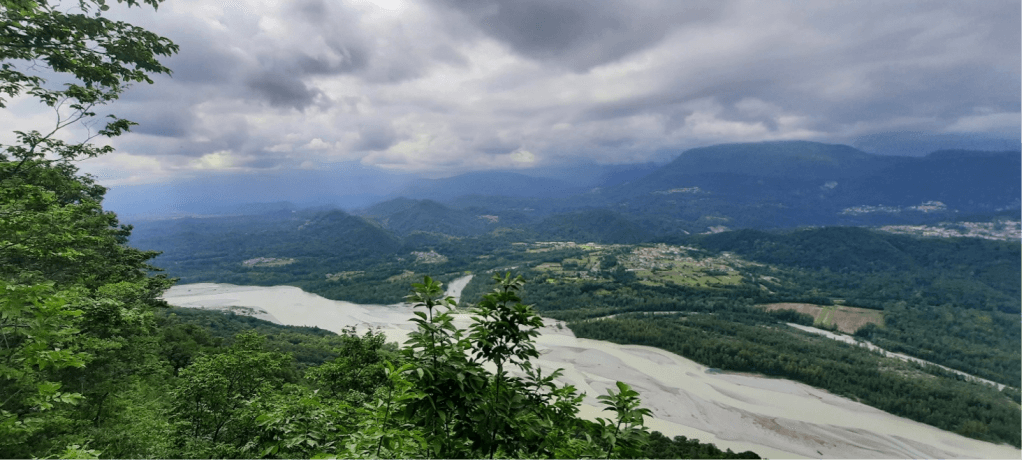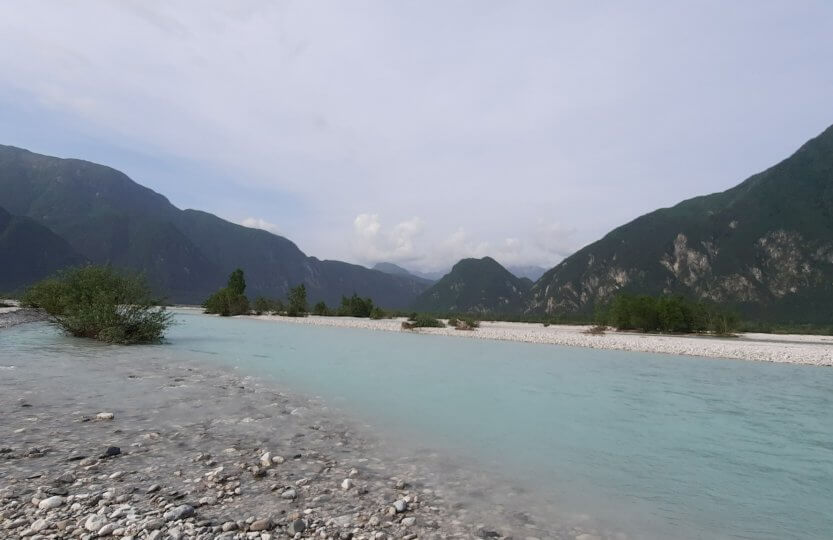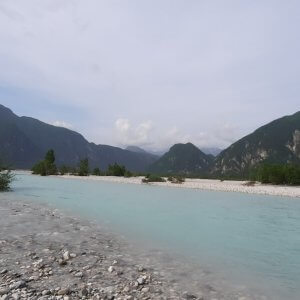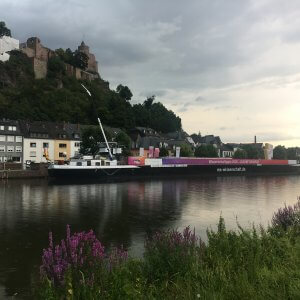Every year, our university offers the Disturbance Ecology Fieldtrip at the Tagliamento River in northern Italy. This trip provides students with a unique opportunity to explore the landscapes and ecological processes of the last wild river in the Alps. I was fortunate enough to participate in last year’s trip, and in this post, I would like to share some of my experiences and impressions.
During the excursion, we traveled along the Tagliamento River from its source to its confluence with the sea. Our scientific journey began in the stunning Alpine region of northern Italy and continued to the Mediterranean lagoons near Bibione. The Tagliamento is one of the last wild rivers in Europe. In some areas, the riverbed is several hundred meters wide, creating ideal conditions for dynamic sedimentation and erosion processes. The photograph illustrates the “braided river” structures and highlights the Tagliamento’s expansive riverbed. The surrounding floodplain soils are important for the rich biodiversity we observed because they provide habitats for numerous plant and animal species.

Figure 1: The “braided river” structures of the Tagliamento.
We examined the features of a natural river that has remained largely unaltered by humans. This is in stark contrast to most rivers in Germany, which have been altered and lack natural wildness. Restoring rivers like the Tagliamento could mitigate flooding problems, which are becoming more frequent in many cities due to climate change.
During the excursion days, participants could sign up for different workshops, which gave me the chance to gain experience in ornithology, zoology, botany, and hydrology. Using binoculars to observe vultures and measuring and sketching the river cross-section were valuable experiences that were completely new to me. I also enjoyed carrying out a saprobic test to assess water quality and examining water bodies for nitrate levels. A particular highlight was catching and identifying various wild bees and butterflies with an expert from the University of Salzburg.
Flower diversity
I was particularly impressed by the variety of flowers in the river meadows. We encountered numerous orchids and several plant species endemic to specific regions of Italy. One of the most fascinating discoveries for me was the common butterwort (Pinguicula vulgaris), a carnivorous plant that traps and digests insects to use them as a source of nitrogen.

Figure 2: The common butterwort (Pinguicula vulgaris).
Then there are the bee orchid (Ophrys apifera) and the late spider orchid (Ophrys holoserica), which closely resemble each other. These orchids imitate the appearance of female bees in order to attract male bees, who then pollinate the flowers. What a fascinating example of coevolution!

Figure 3: The late spider orchid (Ophrys holoserica).
Ecological Perspective
The visit to the limestone fen near Flambro was particularly enlightening, as it is considered one of the most remarkable sites in Europe. The area is characterized by the convergence of various small-scale habitats that provide refuge for many endangered species.
The flora was impressive, but the fauna caught our attention as well. We discovered a western green lizard on the campground by chance. Later, in the Vallevecchia Nature Reserve near the Mediterranean Sea, we spotted a European pond turtle (Emys orbicularis). We even caught a common blue butterfly (Polyommatus icarus). Of course, we released it back into the wild after a few minutes.

Figure 4: The western green lizard, European pond turtle, and common blue butterfly.
Students Activities
During the excursion, students gave presentations on various topics, embodying the spirit of learning reflected by the motto, “Take all the knowledge you can get and don’t let it go.” This approach enabled us to gain in-depth knowledge in a variety of subjects. Our group of over 70 participants included students from various degree programs at several German universities, including those in Bayreuth, Tübingen, Hohenheim, Münster, and Rottenburg.
In the evenings and between activities, we discussed upcoming master’s theses, internships, and research interests. Our group of students from Bayreuth was incredible, and it was delightful to meet students from other programs and hear about their experiences.
We enjoyed an amazing picnic lunch every day, followed by a delicious pizza in the evening. To top it all off, we enjoyed the best Italian ice cream in Gemona!
Personal Impressions
The excursion was full of adventure! We survived several nighttime thunderstorms and nearly lost a car that got stuck in the mud. Of course, we also explored the jungle-like riparian forest of the Tagliamento River.
This excursion was an incredible and unforgettable experience. I gained valuable insights into river systems, geology, and local flora and fauna. I also enjoyed delicious Italian food and met wonderful people who became friends during this exciting journey. I wholeheartedly recommend the Tagliamento excursion and can only praise it.

Figure 5: The riparian forest of the Tagliamento.
I studied geography in my bachelor’s and decided to pursue a master’s degree in Global Change Ecology to deepen my understanding of intertwined global processes. I am especially fascinated by the interactions between climate and vegetation. In addition, the Alps, with their rich biodiversity and dynamic landscapes, are of great interest to me.











Very informative and useful post. Thank you so much for sharing this.
What a riveting read! While I wasnt actually there to measure river cross-sections or catch butterflies (my cross-sections are more accurately described as couch-sections these days), Katrins enthusiasm is truly infectious. It’s fascinating to hear about the flower coevolution – who knew bees were such master manipulators? And the thunderstorms and muddy car? Brings a whole new meaning to Take all the knowledge you can get! Definitely makes one wish for a slice of that Italian pizza, though perhaps not *while* identifying orchids. A thoroughly enjoyable and slightly perilous-sounding adventure!
thanks for this